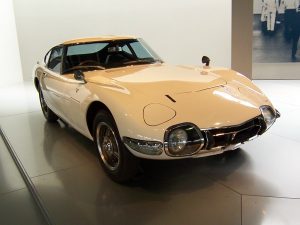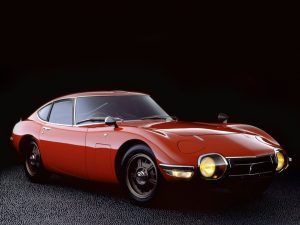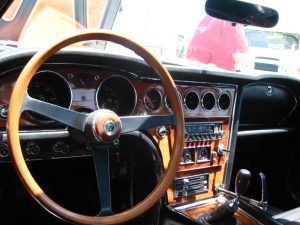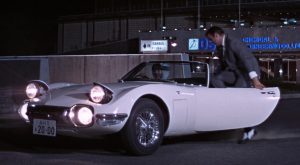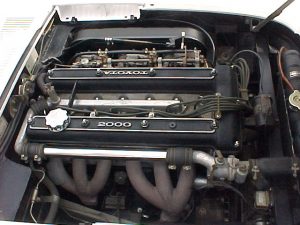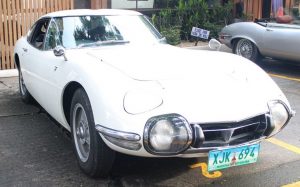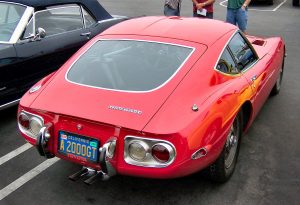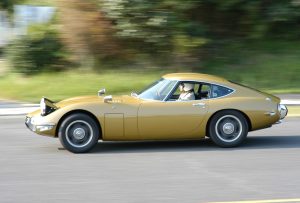The Toyota 2000GT was a sports car produced in very limited numbers by Toyota Motor Company in cooperation with Yamaha. First seen at the 1965 Tokyo Motor Show, production 2000GTs were built between 1967 and 1970 and it revolutionized the automotive world’s view of Japan, which was formerly seen as a producer of imitative and stodgily practical vehicles.

The Toyota 2000GT showed that Japanese automakers can produce a sports car to rival those of Europe. Reviewing a pre-production car in 1967, Road & Track magazine summed up the 2000GT as “one of the most exciting and enjoyable cars we’ve driven”, and compared it favorably to the Porsche 911.
Built By Yamaha For Toyota
Much of the work on producing the Toyota 2000GT was done by Yamaha Motor Company, who in addition to their wide product range of the time, also did much work for other Japanese manufacturers. Many credit the German-American designer Albrecht Goertz, a protégé of Raymond Loewy, as the designer. In the early 1960s, Goertz went to Yamaha in Japan to develop a two-seat sports car for Nissan. A prototype was built but Nissan decided eventually not to pursue the project. Yamaha also worked for Toyota, which was then perceived as the most conservative of the Japanese auto makers. Wishing to improve their image, Toyota accepted the proposal instead, but with a design of their own penned by Toyota designer Satoru Nozaki.
According to Toyota and Yamaha data, only 351 regular production cars of the Toyota 2000GT were built, with 233 MF10s, 109 MF10Ls, and 9 MF12Ls. Contrary to popular belief, all 2000GTs were actually built by Yamaha for Toyota including the body work, engine, running gear and interior, which had Yamaha’s music division crafting the wood rim of the steering wheel and the rosewood-veneer finish of the dashboard. After the 2000GT, Yamaha continued its partnership with Toyota by making engine cylinder heads, specifically the performance-oriented twin-cam 4-valve-per-cylinder models.
European Styling, Japanese Engineering
Many cite the Jaguar E-Type as an influence on the lines, but the design of the 2000GT is widely considered a classic in its own right. The smoothly flowing bodywork was executed in aluminum and featured pop-up headlights with large Plexiglas-covered driving lamps like that on the Toyota Sports 800 mounted in fixed locations on either side of the grille. The car was extremely low, just 45.7 inches (116 centimeters) to the highest point of the roof. In 1969, the front of the car was modified slightly while in 1970, the last few vehicles were fitted with air conditioning and had an automatic transmission as an option. These cars had an additional scoop fitted underneath the grille to supply air to the A/C unit. Two convertibles were built for the James Bond film “You Only Live Twice”, but a factory-produced convertible was never offered for sale to the public during the car’s production run.
The engine of the 2000GT was a 2.0-liter straight-six 3M engine from the top-of-the-line Toyota Crown sedan and was modified by Yamaha with a double overhead camshaft (DOHC) cylinder head and three two-barrel Solex 40 PHH units. Nine special MF-12Ls models were also built with the larger 2.3-liter 2M engine. The engine was mounted longitudinally and drove the rear wheels through a 5-speed manual transmission. A limited slip differential was fitted, and in a first for a Japanese car, power-assisted disc brakes in all four wheels were standard. The car was available with three different final drives and optioned with the 4.375 ratio version, the car was said to be capable of reaching 217 kilometers per hour.
Collectible Production Sports Car
In America during that time, the Toyota 2000GT sold for about $6,800, which was much more than contemporary Porsche and Jaguar sports cars. It is believed that no profit was made on the cars despite their high price since they were more concept cars and a demonstration of Toyota and Yamaha’s ability than a true production vehicle. About 60 cars reached North America and the others were similarly thinly spread worldwide. Three 2000GTs are reportedly in the hands of Filipino collectors and we were lucky enough to see one in the flesh during a meeting of the Manila Sports car Club (MSCC).
Toyota entered the 2000GT in competition at home, coming third in the 1966 Japanese Grand Prix and winning the 1967 Fuji 24-Hour Race. In addition, the car set several FIA world records for speed and endurance in a 72-hour test. Carroll Shelby also entered a pair of 2000GTs in the Sports Car Club of America (SCCA) production car races competing in 1968, the only season in the US that the car competed in. Aside from racing, the 2000GT was made famous by its screen appearances in the James Bond movie, in the TV series “The Ugliest Girl in Town” and “Hawaii Five-0”, and in the highly-popular video game Gran Turismo 4.
Although not quite as well known nowadays to the general public as later Japanese sports cars like the Nissan 240Z, the 2000GT is regarded by many collectors as possibly the first highly collectible Japanese sports car. Today, as the first “Japanese Supercar“, preserved examples of the 1967-70 Toyota 2000GT change hands for fairly high prices. Not bad for a sports car built by a motorcycle company for an automaker of stodgily practical cars.
 Power Wheels Magazine A Notch Above
Power Wheels Magazine A Notch Above

